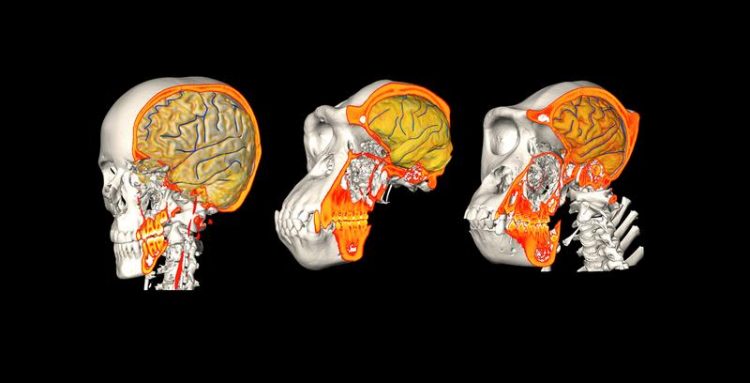The Brain Does not Follow the Head

CT/MRI datasets of a human (left), chimpanzee (center), and gorilla (right). J.L. Alatorre Warren, UZH
The human brain is like a fish in an aquarium, floating inside the liquid-filled braincase – but filling it out almost completely. The relationship between the brain and the braincase, and how they interacted during human evolution, has been occupying the minds of researchers for almost a century.
They addressed this question by studying brain-braincase relationships in our own species, and in our closest living relatives, the great apes.
Quantifying spatial relationships between brain and cranial structures
José Luis Alatorre Warren, researcher at the Department of Anthropology of the University of Zurich, tackled this question using computed tomography (CT) and magnetic resonance imaging (MRI) data from humans and chimpanzees. By combining CT/MRI data, he was able to quantify the spatial relationships between brain structures such as gyri (convolutions) and sulci (furrows) on the one hand, and cranial structures such as bony sutures on the other.
The results show that the characteristic spatial relationships between brain and bone structures in humans are clearly distinct to those in chimpanzees. While the brain and its case continued to evolve side by side, they did so along largely independent evolutionary paths.
Bipedalism leads to changes in braincase
For example, brain structures related to complex cognitive tasks such as language, social cognition and manual dexterity expanded significantly in the course of human evolution. This becomes visible as a shift of the neuroanatomical boundaries of the frontal lobe of the brain. This shift, however, did not affect the bony structures of the braincase.
Instead, changes in the braincase largely reflect adaptations to walking upright on two legs, or bipedalism. For example, the opening at the skull base for the spinal cord moved forward during human evolution in order to optimize balance of the head atop the vertebral column. However, these evolutionary changes to the braincase did not have an effect on our cerebral structures.
Point of reference for future research
“The brain followed its own evolutionary path of neural innovation while freely floating in the braincase,” summarizes Alatorre Warren. “The position and size of braincase bones thus don’t enable us to draw conclusions about evolutionary changes in the size or rearrangement of adjacent brain regions.”
Co-authors Marcia Ponce de León and Christoph Zollikofer believe their study’s data provide an important point of reference for future research: “Having answered the brain-braincase question for humans and great apes, we can now take a fresh look at the braincases of fossil hominids.”
Department of Anthropology
University of Zurich
Prof. Dr. Christoph Zollikofer
Phone: +41 44 635 54 27
zolli@aim.uzh.ch
Dr. José Luis Alatorre Warren
Phone: +41 79 196 75 90
luis.warren@aim.uzh.ch
José Luis Alatorre Warren, Marcia S. Ponce de León, William D. Hopkins, and Christoph P. E. Zollikofer. Evidence for independent brain and neurocranial reorganisation during hominin evolution. PNAS, 14 October 2019. DOI: 10.1073/pnas.1905071116
https://www.media.uzh.ch/en/Press-Releases/2019/Braincase.html
Media Contact
All latest news from the category: Life Sciences and Chemistry
Articles and reports from the Life Sciences and chemistry area deal with applied and basic research into modern biology, chemistry and human medicine.
Valuable information can be found on a range of life sciences fields including bacteriology, biochemistry, bionics, bioinformatics, biophysics, biotechnology, genetics, geobotany, human biology, marine biology, microbiology, molecular biology, cellular biology, zoology, bioinorganic chemistry, microchemistry and environmental chemistry.
Newest articles

NASA: Mystery of life’s handedness deepens
The mystery of why life uses molecules with specific orientations has deepened with a NASA-funded discovery that RNA — a key molecule thought to have potentially held the instructions for…

What are the effects of historic lithium mining on water quality?
Study reveals low levels of common contaminants but high levels of other elements in waters associated with an abandoned lithium mine. Lithium ore and mining waste from a historic lithium…

Quantum-inspired design boosts efficiency of heat-to-electricity conversion
Rice engineers take unconventional route to improving thermophotovoltaic systems. Researchers at Rice University have found a new way to improve a key element of thermophotovoltaic (TPV) systems, which convert heat…



